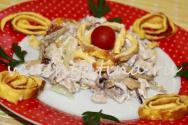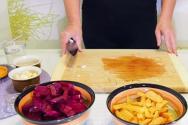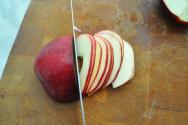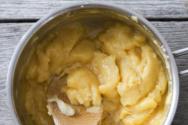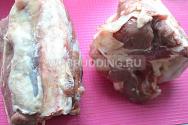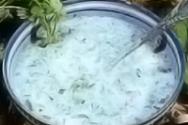Various dishes made from pike perch caviar. Pike perch caviar: beneficial properties of pike perch caviar Is it possible to salt pike perch caviar after defrosting?
Pike perch caviar is a source of easily digestible protein, vitamins B, C, A, E, amino acids, calcium, magnesium, zinc, copper, iron, nickel, manganese. Prepared from this product various dishes, but caviar turns out to be especially tasty home salting.
Pike-perch caviar: how to cook?
How to salt pike perch caviar
To pickle caviar, you will need:
800 g of caviar; - 300 g of salt for solution; - 3 liters of water for solution; - 1 teaspoon of salt; - 4 tablespoons of oil.
Place pike perch caviar in a deep cup and chop it with a sharp knife. Now pour a boiling solution of table salt (from 1 liter of water and 100 g of salt) and stir it well with a fork so that films wrap around it. Then drain the liquid, prepare a new solution from water and salt, taken in the same quantity, and pour pike perch caviar again. Repeat the manipulation with a fork, drain the brine again and remove the films. Pour the cleaned caviar one last time with boiling water and salt prepared from the last 100 g of salt and a liter of water. Mix thoroughly again and place in a fine sieve for 15 minutes.
Clean liter jar pour 2 tablespoons vegetable oil, fill it 70% with caviar, add a heaped teaspoon of salt and stir. Now fill the jar with caviar and pour another 2 tablespoons of vegetable oil on top. Close the jar with a lid and put it in the refrigerator, after 5 hours it can be eaten. The caviar turns out lightly salted, crumbly, and delicate yellow in color.
You can make wonderful sandwiches from salted pike perch caviar. To do this, spread butter on slices of loaf, place caviar on top and garnish with herbs
Pike-perch caviar pancakes
Pike perch caviar makes delicious pancakes. To prepare them, you will need: - 150 g of caviar; - 1 carrot; - 1 onion; - salt to taste; - 1 tablespoon of vegetable oil; - 1 tablespoon of flour; - 1 tablespoon of starch; - 1 egg.
Wash the pike perch caviar, remove the film and grind with a blender. Pass the carrots through a fine grater, cut the onion into several pieces and also pass them through a blender. Mix caviar, vegetables, egg and vegetable oil in a bowl. Add flour and starch to the finished mixture and mix thoroughly again.
Fry thin pancakes in a preheated non-stick frying pan until golden brown. Serve with vegetable salad and sour cream sauce.
Despite the fact that there are periods of spawning prohibition, amateur fishermen, depending on the fishing rules of a particular basin, are allowed at this time to do a little fishing with certain gear from the shore outside the spawning areas. And it happens that a fisherman comes across fish with caviar. If you followed the rules when fishing, then with a clear conscience you can pickle caviar at home. This is an incredibly tasty and valuable dish. And it doesn’t matter whether it will be perch caviar, pike caviar, pike perch caviar, bream caviar or other fish. If you know, how to salt caviar correctly at home and have proven ones in your piggy bank caviar salting recipes, your pleasure is guaranteed.
What you need to know before salting caviar at home:
- Caviar for salting must be fresh, that is, extracted from freshly caught fish.
- The fattier the fish and the larger the caviar, the more enjoyable it will be for you to eat.
- First of all, popular recipes for salting the caviar of pike, pike perch, crucian carp, bream, you can pickle the caviar of perch.
- It is important to clean the eggs from the chaff: open the film and rub the back of your hand through an enamel colander - an aluminum colander is not suitable, because its sharp edges will ruin the eggs.
How to simply salt caviar at home - a universal recipe:
To salt fish roe at home, you will need enamel pan, gauze, as well as water, salt, seasonings (bay leaf, black and allspice). Pour three times more water into the pan than prepared caviar. Let the water boil and add plenty of salt and omit the seasonings. Next, you need to turn off the stove and pour caviar into the prepared water, remembering to stir. Let it stand under the lid for about 15 minutes, and then discard the caviar through cheesecloth. The cooled caviar is put into the refrigerator. Store for about a month.
How to salt pike perch caviar
Pike perch in itself is an excellent fishing trophy. A pike perch caviar– a source of easily digestible protein, vitamins B, C, A, E, amino acids, calcium, magnesium, zinc, copper, iron, nickel, manganese. Pike-perch caviar can be fried, but it turns out no less tasty home-salted pike perch caviar.
To pickle caviar, you will need:
- 800 g of caviar, 300 g of salt for solution, 3 liters of water for solution, 1 teaspoon of salt, 4 tablespoons of oil.
Recipe for salting pike perch caviar: Place pike perch caviar in a deep cup and chop it with a sharp knife. Pour a boiling solution of table salt from 1 liter of water and 100 g of salt and stir it well with a fork so that films wrap around it. Then drain the liquid, prepare a new solution from water and salt, taken in the same quantity, and pour pike perch caviar again. Repeat the manipulation with a fork, drain the brine again and remove the films. Pour the cleaned caviar one last time with boiling water and salt prepared from the last 100 g of salt and a liter of water. Mix thoroughly again and place in a fine sieve for 15 minutes. Pour 2 tablespoons of vegetable oil into a clean liter jar, fill it 70% with caviar, add a heaped teaspoon of salt and stir. Now fill the jar with caviar and pour another 2 tablespoons of vegetable oil on top. Close the jar with a lid and put it in the refrigerator, after 5 hours it can be eaten. The caviar turns out lightly salted, crumbly, and delicate yellow in color.
Now you know, how to salt pike perch caviar at home.

How to salt pike caviar
Home-salted pike caviar is an exquisite delicacy. Pike caviar is in no way inferior in taste to recognized delicacies, and we can talk endlessly about its benefits. Unlike black and red caviar, it is considered more dietary due to its low fat content, but the benefits of pike caviar are its high content of protein, microelements and vitamins A and D. In Rus', pike caviar was eaten with pancakes, and it was highly valued. Every angler should have a few recipes for salting caviar pike at home.
Recipe 1
To pickle caviar, you will need:
- pike caviar – 550 grams, salt – 2 tablespoons, vegetable oil – 10 ml.
Recipe for salting pike caviar: Rinse the pike thoroughly and carefully remove the eggs in bags. Rinse the pike caviar and remove the eggs from the bags, making sure that there are no remaining film residues in the caviar. Add salt to the caviar and whisk thoroughly with a fork until the salt has dissolved - approximately 20 minutes. Pike caviar is ready for salting as soon as a white foam appears. Now add 2/3 of the vegetable oil to the caviar and mix well. Place the caviar in a glass jar or saucepan, and pour the remaining oil on top. Cover the container tightly with a lid and refrigerate for 5 days. Pike caviar prepared according to this recipe is ready to eat in five days.
Recipe 2
If you are impatient to enjoy the taste of home-salted pike caviar, then take note growth and quick recipe salting pike caviar.
To pickle caviar, you will need:
- pike caviar – 300 grams, water, salt.
Simple recipe quick salting pike caviar:
Without removing the pike caviar from the bags, place it in a deep bowl and use a fork. Pour 1.5 liters of boiling water into the caviar and stir it for another five minutes, removing the films. Drain the hot water and pour in the caviar cold water, drain again, stirring and removing films. Washing the caviar requires thorough and long-lasting procedures; it may take 10 procedures or even more. After this, the caviar should be dried. Salt the dried caviar to taste and stir until the salt dissolves. The caviar can be transferred to a jar and stored in the refrigerator. After 6 hours it is ready to eat.
Ingredients:
100–150 g pike perch caviar
1 onion
1 bunch of green onions
1 bunch of lettuce
2 tbsp. spoons of vegetable oil
juice of 1 lemon
Salt - to taste
Ground black pepper - to taste
How to prepare an appetizer from pike perch caviar:
- Scald the purchased pike perch caviar, which is usually kept inside the fish in a film bag, with boiling water, then remove all the films and pour the caviar onto a layer of gauze in a colander. Rinse it well under running cool water. After this, set the caviar aside for 12–15 minutes.
- Peel the onion, finely chop and place in a serving bowl, pour lemon juice over the caviar and sprinkle with a pinch of black pepper and salt.
- Place green salad leaves on a large, flat plate, sprinkle finely chopped onion on top and pour a little oil over the vegetables.
- Place caviar on top of all these ingredients. Excellent cold appetizer zander caviar is ready!
Food52
Ingredients:
500 g pike perch caviar
2 medium ripe tomatoes
2 tbsp. spoons of sour cream
fresh herbs
salt and pepper - to taste
How to cook pike perch caviar with tomatoes:
- Wash the vegetables thoroughly and cut into thin slices.
- Heat a small amount of oil in a frying pan and fry the tomatoes until golden brown.
- In a separate bowl, season the pike perch caviar with salt and pepper and let it steep in the refrigerator for 40–45 minutes. After this time, add pike perch caviar to the same oil in which the tomatoes were fried and also fry until a crust forms (usually from 5 to 8 minutes).
- Place the caviar in the center of a serving dish, mix the tomatoes with sour cream and “surround” the caviar with them.
- Garnish pike perch caviar with tomatoes with a sprig of herbs.
 Shutterstock
Shutterstock
Ingredients:
200–250 g pike perch caviar
1 chicken egg
1 glass wheat flour
soda on the tip of a knife
1 drop of vinegar
2 cups kefir
1 onion
pepper and salt - to taste
How to cook pancakes with pike perch caviar:
- Peel and grate the onion, separate the caviar from the films, then lightly pepper and salt the ingredients, then lightly fry until pre-cooked without crust.
- In a separate deep bowl, break the egg, quench the soda with vinegar and add it to the egg, add flour and kefir. Mix the ingredients well until a smooth and liquid dough forms.
- Fry the pancakes in a frying pan for 2 minutes on each side.
- When serving on pancakes, place pike perch caviar with onions on top. If desired, decorate with sprigs of fresh herbs.
 Shutterstock
Shutterstock
Ingredients:
200–300 g bread
150–200 ml milk
300–400 g pike perch caviar
½ onion
salt and pepper - to taste
butter for frying
How to cook casserole with pike perch caviar:
- Soak the bread in milk for literally 10 minutes, then pass it through a meat grinder and add pike perch caviar to the bread. Chop the onion and place in a container with the rest of the ingredients. Add a little salt and pepper, then mix well.
- Grease a casserole dish with butter, place the bread-caviar mixture into it and bake the dish for 18–20 minutes at 180°C.
- Original casserole with pike perch caviar ready!
At home, you can salt the caviar of any fish, as long as it is freshly caught. Home-salted caviar is especially good in a duet with rye bread. Sandwiches with it will be an excellent addition to your menu. We will learn how to properly salt caviar at home, what recipes for salting caviar to use, and how to salt caviar of pike, pike perch and perch. Simple recipes will help you salt caviar correctly and diversify your table with this delicacy.
How to salt caviar?
Despite the fact that there are periods of spawning prohibition, amateur fishermen, depending on the fishing rules of a particular basin, are allowed at this time to do a little fishing with certain gear from the shore outside the spawning areas. And it happens that a fisherman comes across a fish with caviar. If you followed the rules when fishing, then with a clear conscience you can pickle caviar at home. This is an incredibly tasty and valuable dish. And it doesn’t matter whether it’s perch caviar, pike caviar, pike perch caviar, bream caviar or other fish. If you know how to properly salt caviar at home and have proven recipes for salting caviar, your pleasure is guaranteed.

What you need to know before salting caviar at home:

Caviar for salting must be fresh, that is, extracted from freshly caught fish.

The fattier the fish and the larger the caviar, the more enjoyable it will be for you to eat.
First of all, popular recipes for salting the caviar of pike, pike perch, crucian carp, bream, you can pickle the caviar of perch.

It is important to clean the eggs from the chaff: open the film and wipe with the back of your hand through an enamel colander - an aluminum colander is not suitable, because its sharp edges will ruin the eggs.

How to simply salt caviar at home - a universal recipe:

To salt fish caviar at home, you will need an enamel pan, gauze, as well as water, salt, seasonings (bay leaf, black and allspice. Pour water into the pan three times more than prepared caviar. Let the water boil and pour plenty of salt, omit the seasonings. Next, you need to turn off the stove and pour the caviar into the prepared water, not forgetting to stir. Let it stand under the lid for about 15 minutes, and then discard the caviar through cheesecloth. The cooled caviar is put in the refrigerator. Stored for about a month.

How to salt pike perch caviar?
Pike perch in itself is an excellent fishing trophy. And pike perch caviar is a source of easily digestible protein, vitamins B, C, A, E, amino acids, calcium, magnesium, zinc, copper, iron, nickel, manganese. Pike perch caviar can be fried, but home-salted pike perch caviar is no less tasty.
800 g of caviar, 300 g of salt for solution, 3 liters of water for solution, 1 teaspoon of salt, 4 tablespoons of oil.
Recipe for salting pike perch caviar:
Place pike perch caviar in a deep cup and chop it with a sharp knife. Pour a boiling solution of table salt from 1 liter of water and 100 g of salt and stir it well with a fork so that films wrap around it. Then drain the liquid, prepare a new solution from water and salt, taken in the same quantity, and pour pike perch caviar again. Repeat the manipulation with a fork, drain the brine again and remove the films. Pour the cleaned caviar one last time with boiling water and salt prepared from the last 100 g of salt and a liter of water. Mix thoroughly again and place in a fine sieve for 15 minutes.
Pour 2 tablespoons of vegetable oil into a clean liter jar, fill it 70% with caviar, add a heaping teaspoon of salt and stir. Now fill the jar with caviar and pour another 2 tablespoons of vegetable oil on top. Close the jar with a lid and put it in the refrigerator, after 5 hours it can be eaten. The caviar turns out lightly salted, crumbly, and delicate yellow in color.
Now you know how to salt pike perch caviar at home.
How to salt pike caviar?
Home-salted pike caviar is an exquisite delicacy. Pike caviar is in no way inferior in taste to recognized delicacies, and we can talk endlessly about its benefits. Unlike black and red caviar, it is considered more dietary due to its low fat content, but the benefits of pike caviar are its high content of protein, microelements and vitamins A and D. In Rus', pike caviar was eaten with pancakes, and it was highly valued. Every angler should have several recipes for salting pike caviar at home.
To pickle caviar you will need:
Pike caviar - 550 grams, salt - 2 tablespoons, vegetable oil - 10 ml.
Recipe for salting pike caviar:
Rinse the pike thoroughly and carefully remove the eggs in bags. Rinse the pike caviar and remove the eggs from the bags, making sure that there are no remaining film residues in the caviar. Add salt to the caviar and whisk it thoroughly with a fork until the salt has dissolved - approximately 20 minutes. Pike caviar is ready for salting as soon as a white foam appears. Now add 2/3 of the vegetable oil to the caviar and mix well. Place the caviar in a glass jar or saucepan, and pour the remaining oil on top. Cover the container tightly with a lid and refrigerate for 5 days. Pike caviar prepared according to this recipe is ready to eat in five days.
If you are impatient to enjoy the taste of home-salted pike caviar, then take note of a simple and quick recipe for salting pike caviar.
To pickle caviar you will need:
Pike caviar - 300 grams, water, salt.
A simple recipe for quick salting of pike caviar:
Without removing the pike caviar from the bags, place it in a deep bowl and use a fork. Pour 1.5 liters of boiling water into the caviar and stir it for another five minutes, removing the films. Drain the hot water and pour cold water over the caviar, drain again, stirring and removing the films. Washing the caviar requires thorough and long-lasting procedures; it may take 10 procedures or even more. After this, the caviar should be dried. Salt the dried caviar to taste and stir until the salt dissolves. The caviar can be transferred to a jar and stored in the refrigerator. After 6 hours it is ready to eat.
How to salt perch caviar?
Perch is one of the most common fish in Russia. It is found in the fresh water of large reservoirs, ponds, rivers, and lakes. Only if you caught perch with caviar, try preparing salted perch caviar. To make it really tasty, you need to salt it correctly. To help you simple recipes salting that will make perch caviar aromatic, tasty and healthy: perch caviar contains folic acid, potassium, phosphorus, omega-3 fatty acids and protein.
Recipe for salting perch caviar with marinade.
To pickle caviar you will need:
Caviar of one perch, 1 liter of water, 2 tbsp. l. salt, 1/2 tsp. ground coriander, 10 black peppercorns, 4 allspice peas, 2 bay leaves.
Recipe for salting perch caviar: rinse the perch caviar under warm running water. During the washing process, do not remove the caviar from the bags. Free the caviar from the film. To do this, arm yourself with a fork or spoon. These cutlery will greatly facilitate the process of separating the eggs from the film. Prepare the marinade. To do this, pour water into the pan and add salt. Add bay leaf, coriander, black peppercorns and allspice. Bring to a boil and cook for 20 minutes. Pour the hot marinade over perch caviar and stir vigorously. Let the caviar brew for 20 minutes. Drain the marinade using a colander. Make a water bath. To do this, pour water into a large saucepan and place a smaller saucepan in it. Place caviar in the last one. Boil it for 15-20 minutes. During the cooking process, caviar must be stirred with enviable regularity. Ready perch caviar should be crumbly and white. Similar heat treatment will completely relieve it of its specific astringency. Ready caviar can be slightly salted to taste. Only if it turns out to be a bit dry, add a few drops of vegetable oil to it. Bon appetit!
How to properly salt trout caviar
Pour a liter of water into the pan, add 1 ½ tbsp. tablespoons of salt (large heap) and a teaspoon of sugar. Place the pan with the brine on the stove, bring it to a boil and cook until the sugar and salt are completely dissolved. Remove the pan from the heat, cool the brine to 50-60 º. Place the yastyki with red caviar in the cooled brine.
Is it possible to salt frozen pink salmon caviar?
The process of salting frozen caviar: Defrost the caviar, remove the films, add water and add 35 grams of salt, heat over low heat, stirring. In a saucepan, make a new solution using the remaining water, sugar and salt. Drain the brine, place the product on cheesecloth and dry. Divide into jars, add a little oil.
 Pike caviar is rightly considered a royal delicacy for its taste. And it unfairly takes third place after red and black caviar. Dietary due to its low fat content, pike caviar is a valuable source of proteins, microelements and nutrients. It can also be an aphrodisiac. If you caught a pike and found eggs with caviar in it, you can, of course, take them apart and pickle the caviar in granular form. But playing with one or two spoons will take the same amount of time as playing with a kilogram. So, dear fisherman, catch pike large and small, so as not to salt two or three spoons of caviar. What is needed for salting caviar First of all, we will wash the caviar, so you will need clean water. Lots of clean water. And also salt, it is advisable to use fine salt and sea salt; sea salt makes the caviar more transparent. There are many recipes for salting pike caviar, more on them later, and the ingredients used in the salting process are just as varied. They put vegetable oil, potatoes, and even all kinds of seasonings in the caviar. To salt pike caviar, you will need pike with caviar or already separated eggs (bags with caviar). Water. Sea salt. Sunflower oil. Utensils for cleaning caviar: sieve, grater, fork, colander, gauze, possibly a meat grinder and mixer.
Pike caviar is rightly considered a royal delicacy for its taste. And it unfairly takes third place after red and black caviar. Dietary due to its low fat content, pike caviar is a valuable source of proteins, microelements and nutrients. It can also be an aphrodisiac. If you caught a pike and found eggs with caviar in it, you can, of course, take them apart and pickle the caviar in granular form. But playing with one or two spoons will take the same amount of time as playing with a kilogram. So, dear fisherman, catch pike large and small, so as not to salt two or three spoons of caviar. What is needed for salting caviar First of all, we will wash the caviar, so you will need clean water. Lots of clean water. And also salt, it is advisable to use fine salt and sea salt; sea salt makes the caviar more transparent. There are many recipes for salting pike caviar, more on them later, and the ingredients used in the salting process are just as varied. They put vegetable oil, potatoes, and even all kinds of seasonings in the caviar. To salt pike caviar, you will need pike with caviar or already separated eggs (bags with caviar). Water. Sea salt. Sunflower oil. Utensils for cleaning caviar: sieve, grater, fork, colander, gauze, possibly a meat grinder and mixer.
But the most difficult and time-consuming part of the salting process will be the preparation stage. Therefore, it will take a lot of time and patience. Preparing the fish and caviar We wash the pike very thoroughly and clean out the giblets. We pull out the bags of caviar (oids) from the fish. The eggs must be “rescued” from these bags, the film must be removed and the eggs must be cleaned of blood, films and other debris. There are several ways: You can pass the eggs through a meat grinder, but there is a risk that the film will wrap around on not very sharp knives and you will have to take everything apart to clean it. And if the knife in the meat grinder is sharpened well, then the film will be cut, and you will need to look for it and catch it among the eggs. Another “quick” method of cleaning caviar from the venous film is used by experienced lovers of salting caviar. This is a method using a mixer. Everything is simpler here - the film is simply wound onto the mixer blades, and it will not be difficult to remove it from there. To clean caviar from film, you can use coarse grater, rubbing bags of caviar on it. All the film, veins and blood will remain in your hands. In a similar way, you can separate the caviar from the film through a sieve. But most often an ordinary fork, a colander and plenty of water are used. Place the bags in a bowl with a volume three times the volume of caviar, and fill it almost to the top with boiling water. Take a fork and start stirring lightly for five minutes so that the films dissolve and rise to the top. Use a spoon to skim off the foam and floating eggs. Drain the boiling water and fill the caviar with cold water. Mix again, drain and fill the bowl with water again. We continue this way until the drained water becomes completely transparent and all the films are gone. It may be necessary to repeat the procedure more than 10-15 times so that the caviar is cleared of unnecessary debris. When you get rid of all the debris and all the films in the caviar, strain it through cheesecloth. To do this, fold a large piece of gauze in two or four times so that the strained caviar fits into the resulting piece of gauze. Line a sieve or colander with this piece of gauze and pour the caviar and water into it. When the water has drained, twist the gauze with the caviar into the bag and press down a little so that excess water comes out. Now the caviar is ready for further procedures. IMPORTANT! Check to see if there is any nasty stuff left in the caviar - films, veins or blood. Recipes for salting pike caviar Simple pickling with sunflower oil 500 gr. pike caviar, 3 tablespoons of salt, 100 ml of vegetable oil.
Sprinkle the cleaned and washed caviar with salt. Beat with a fork until white foam appears (about 15 minutes). Pour in two-thirds of the oil, mix thoroughly and put in the refrigerator. Now we need to prepare glass jars for storing caviar. You can use cans baby food, horseradish or mustard, the main thing is small volume. Sterilize jars in boiling water or electric oven within 10-15 minutes. Place the lids of the jars in a saucepan and heat until boiling. Let it simmer for about five minutes. Sterilized jars need to be cooled, add caviar and pour on top sunflower oil layer 1 cm thick. Screw the lid tightly and put the caviar in jars in the refrigerator for 5 days. After that you can eat it. Bon appetit! “Hot” method of salting caviar: pike caviar, sea salt (for 500 grams of caviar, 2 tablespoons of salt), sunflower oil.
In this method, the caviar must fall into a boiling mixture of water and salt. If you add 400 grams of salt to 1 liter of water, then this very salty solution is called brine. You need to cook the brine for a couple of minutes, then add the caviar. Immediately remove from heat and strain. The oil is added only before serving the caviar. However, caviar prepared using the “hot” method is stored in the refrigerator for two to three days. Although, it is unlikely that this delicacy will stand “idle” even for one day. Five-minute recipe It takes a long time to prepare, but the caviar is eaten in five minutes. For 200 grams of pike caviar we take 1 liter of water. put on fire and pour finely ground sea salt - 2 tbsp for each liter. bring the brine solution to a boil and add seasonings and spices. Any, to your taste. You can just use a mixture of peppers. Pour the cleaned and washed caviar into a boiling salt solution with seasonings and leave for 10-15 minutes.
1 kg. pike perch 150 g salt peppercorns and bay leaf to taste The fish must be cleaned of scales, gutted all the insides. Rinse. If the fish is large, then you must make an incision along the back. This is necessary in order to avoid its damage. Then you need to take 150 grams of coarse salt, it’s even better to use sea salt. Rub thoroughly all over the fish, especially the gills and cuts on the back.
Place the prepared fish belly up in a wooden barrel. If there is a lot of fish, then each row of fish should be sprinkled with salt and peppercorns and bay leaves should be added. The most salt should be placed on the top rows. Then the barrel must be closed with a lid and pressure placed on top. 
To salt large fish, you should keep it in a cool place for 15 days. If the fish is small, then 5 days will be enough for it. After the specified time has elapsed, the pike perch must be removed and washed in cold water to remove excess salt. Then hang it in a cool and ventilated area to dry.
It will be a very difficult, rather tedious task to clean the caviar from the film of the egg. Once you get the hang of it, you can rub the caviar through the grate, instead of which a badminton racket is often used. All the eggs fall into the cells, and the film remains on the grates. Here you need to get used to it and just wipe the caviar, and not push it through.
Another good way to clean the yastiks, take a piece of gauze folded in four, moisten it in a strong brine, fold all the yastiks on both sides, the two of us take hold of the ends and begin to roll the caviar over the gauze, all the pieces of film remain on it, then carefully dump the caviar into a basin.

But I gave these methods if there is a lot of caviar, several kilograms. We are used to always doing it using basins. And then you sit and eat a sandwich from a loaf cut lengthwise, spread with still warm caviar, washing it down with coffee from a half-liter mug, and even adding it to your mouth with a spoon.
If there is not much caviar, say from one fish, then you can simply pour hot water into a cup (so that only your hand can tolerate it), sprinkle a little salt and put the eggs there. Just mash them a little in water and they will easily separate; all that remains is to remove the entire film, since it tastes unpleasantly hard.
The whole procedure takes about an hour. 1. Take out two eggs with caviar and rinse in water to wash off the blood. 
 2. Take gauze, fold it into two layers with a groove and begin to roll out the caviar on it. This is necessary to separate the eggs from the film. The process is not very fast and takes about 10 minutes for a couple of fish from one fish.
2. Take gauze, fold it into two layers with a groove and begin to roll out the caviar on it. This is necessary to separate the eggs from the film. The process is not very fast and takes about 10 minutes for a couple of fish from one fish.  3. At the same time, someone is preparing “tuzluk” - a strong saline solution. Salt can be dissolved in cold water, but it is more convenient in hot water. Let the water cool to 30-40 degrees. 4. Dip the caviar, cleared of film, into the brine for 5-10 minutes. 5. Drain the water, transfer the eggs into a gauze bag and hang it on a tree so that all the liquid drains away.
3. At the same time, someone is preparing “tuzluk” - a strong saline solution. Salt can be dissolved in cold water, but it is more convenient in hot water. Let the water cool to 30-40 degrees. 4. Dip the caviar, cleared of film, into the brine for 5-10 minutes. 5. Drain the water, transfer the eggs into a gauze bag and hang it on a tree so that all the liquid drains away.  All. After 20-30 minutes the dish is ready.
All. After 20-30 minutes the dish is ready.
- Don't be afraid to crush the eggs. In fresh fish they are very strong.
- The eggs will come away from the film better if you pour boiling water over them.
How to salt trout caviar. A few secrets of salting trout caviar
- In many ways, the successful result of salting trout caviar at home depends on the quality of the ingredients. You can salt both fresh and frozen caviar. The latter must be properly defrosted before cooking - keep the caviar in the refrigerator for 12 hours, and then leave it at room temperature to completely defrost.
- Before proceeding to the main stage, you need to prepare the necessary equipment, namely a glass jar or other container made of non-oxidizing material in which the finished product will be stored, a sieve for washing the caviar, and a sharp knife.
- If the caviar suddenly turns out to be very salty, do not be upset, because by rinsing it with boiled water and black tea, you can remove excess salt.
- It is recommended to store trout caviar salted at home in the refrigerator for no more than 75 days.
Video How to pickle fish eggs at home.
How to fry caviar. Fried caviar: simple and a little more complicated
First you need to make sure that the caviar is mature: the eggs should be visible individually, and not look like a cloudy mass. Unripe caviar is unlikely to produce tasty dish. Before frying the caviar river fish, it must first be washed and then cleared of the remaining film of the caviar sac. The simplest, “folk” way of such cleaning is to smoothly squeeze a handful of caviar in your fist.
In this case, the eggs seep between the fingers, and the films remain inside the handful. Remove small leftovers with a knife or fork. Then you need to salt the caviar generously, add ground pepper and mix thoroughly. Finely chopped onions are fried, and then caviar is placed in a frying pan with boiling oil and onions. You need to fry the caviar, continuously stirring the contents of the pan. Fried caviar changes color, which serves as a guide to which fragments are already approaching the stage of readiness, and which still need to be fried.
You can follow a simple path - do not stir the caviar, but wait until one side is completely fried, turn it over to the other side, bring it to readiness, and at this point the dish can be considered ready. You can serve it as an addition to a side dish, or you can serve it on its own. A slightly more difficult way is to wait, stirring continuously, until all the caviar mass is well fried. It will absorb all the oil and acquire a golden hue with an orange tint. When hot, transfer it to another bowl, add butter, finely chopped greens, you can also add pepper. Then mix everything with a mixer or blender. Fried eggs have become harder, they will no longer turn into porridge. The resulting paste can be placed on croutons flavored with garlic.
